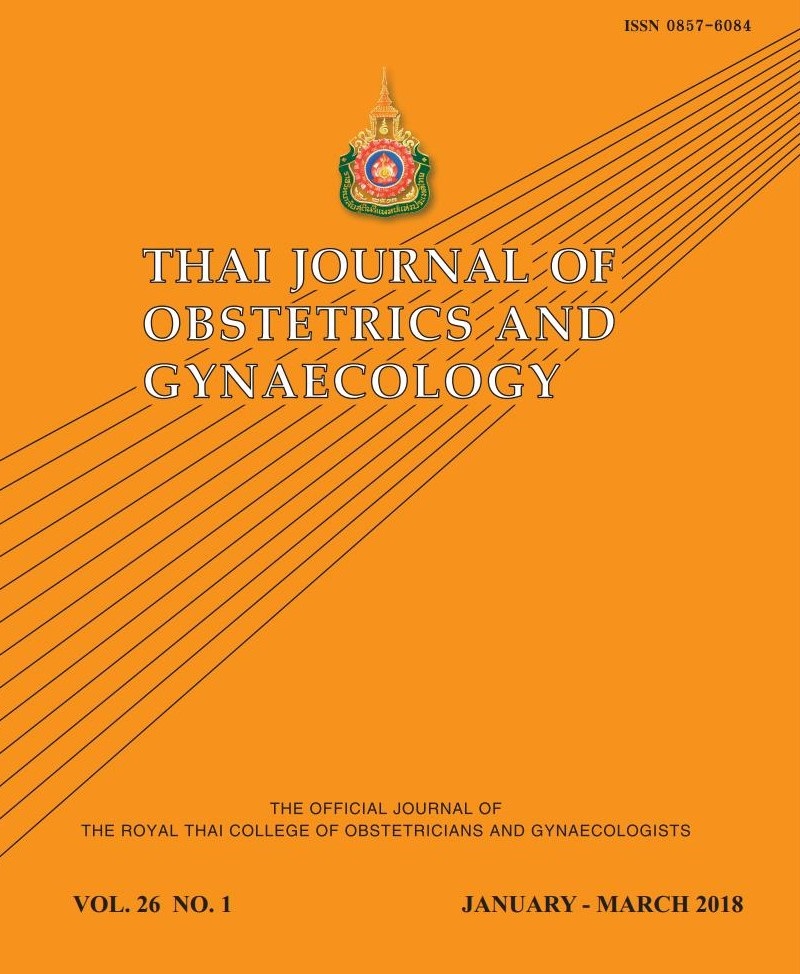Gel Pack Reduced Postoperative Pain in Benign Gynecologic Surgery: A randomized controlled trial
Main Article Content
Abstract
Objective: To examine the effectiveness of gel pack for reducing postoperative pain in patient who undergoes exploratory laparotomy for benign gynecologic surgery.
Materials and Methods: Twenty eight participants who underwent benign gynecological surgery under general anesthesia at Khon Kaen Hospital in March 2016 were randomized by computer generated into two groups: gel pack group (N=14) and control group (N=14). Gel pack was applied at 2 hours after operation for 20 minutes and pain score was measured using visual analog scale (VAS) at 2 (baseline), 6 and 24 hours, respectively. The VAS was divided into two grades by pain-intensity; mild (VAS<4), and moderate to severe (VAS≥4). The comparison of pain- intensity was analyzed by Fisher exact test (p<0.05).
Results: Gel pack was statistically significant reduced postoperative pain from moderate-severe pain to mild pain intensity at 6 hours compared with control group (11 to 8 cases versus 14 to 14 case, p=0.01, 95%CI 0.03-0.89). There was no statistically significant difference in opioid consumption, hospital stay and wound infection between two groups.
Conclusions: Gel pack can reduce postoperative pain at 6 hour in benign gynecological operation without complication.
Keywords: Gel pack, exploratory laparotomy, benign gynecologic surgery, postoperative pain
Article Details
References
2. Hamitouche Y, Benhamou D. Postoperative pain relief after gynecologic surgery. J Gynecol Obstet Biol Reprod (Paris). 2004;33(1 Pt 1):7–13.
3. Elsa W, Maureen FC. Acute Pain: Assessment and Treatment. Advances practice nursing eJournal. Available from: https://www.medscape.com/viewarticle/735034
4. Chanliongco PM. Cold (Cryo) Therapy. In: Walkowski S, Singla AK, Vivian DG, Lennard TA, editors. Pain Procedures in Clinical Practice. 3rd ed. Saint Louis: Hanley & Belfus; 2011. p. 555.
5. Cryotherapy: A Review of the Literature. Chiroaccess article 2008. Available from: https://www.chiroaccess.com/articles/cryotherapy-a-review-of-the-literature.aspx?id=0000070
6. Akan M, Misirlioğlu A, Yildirim S, Cakir B, Taylan G, Aköz T. Ice application to minimize pain in the split-thickness skin graft donor site. Aesthetic Plast Surg. 2003;27(4):305–7.
7. Waterman B, Walker JJ, Swaims C, Shortt M, Todd MS, Machen SM, et al. The efficacy of combined cryotherapy and compression compared with cryotherapy alone following anterior cruciate ligament reconstruction. J Knee Surg. 2012;25(2):155–60.
8. Rotenberg BW, Wickens B, Parnes J. Intraoperative ice pack application for uvulopalatoplasty pain reduction: a randomized controlled trial. Laryngoscope. 2013;123(2):533–6.
9. Forouzanfar T, Sabelis A, Ausems S, Baart JA, van der Waal I. Effect of ice compression on pain after mandibular third molar surgery: a single-blind, randomized controlled trial. Int J Oral Maxillofac Surg. 2008;37(9):824–30.
10. East CE, Begg L, Henshall NE, Marchant P, Wallace K. Local cooling for relieving pain from perineal trauma sustained during childbirth. Cochrane Database Syst Rev. 2007;(4):CD006304.
11. Kanlayanaphotporn R, Janwantanakul P. Comparison of skin surface temperature during the application of various cryotherapy modalities. Arch Phys Med Rehabil. 2005;86(7):1411–5.
12. Jones KR, Vojir CP, Hutt E, Fink R. Determining mild, moderate, and severe pain equivalency across pain-intensity tools in nursing home residents. J Rehabil Res Dev. 2007;44(2):305–14.
13. Habib AS, Wahl K, Gu J, Gan TJ, Adenosine Study Group. Comparison of postoperative pain outcomes after vertical or Pfannenstiel incision for major gynecologic surgery. Curr Med Res Opin. 2009 Jun;25(6):1529–34.
14. Koç M, Tez M, Yoldaş O, Dizen H, Göçmen E. Cooling for the reduction of postoperative pain: prospective randomized study. Hernia. 2006;10(2):184–6.
15. Watkins AA, Johnson TV, Shrewsberry AB, Nourparvar P, Madni T, Watkins CJ, et al. Ice packs reduce postoperative midline incision pain and narcotic use: a randomized controlled trial. J Am Coll Surg. 2014;219(3):511–7.
16. Finan MA, Roberts WS, Hoffman MS, Fiorica JV, Cavanagh D, Dudney BJ. The effects of cold therapy on postoperative pain in gynecologic patients: a prospective, randomized study. Am J Obstet Gynecol. 1993;168(2):542–4.


